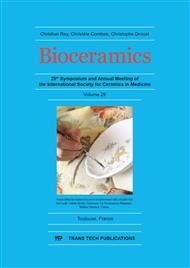[1]
C. Rey, C. Combes, What bridges mineral platelets of bone? Bonekey Rep. 3 (2014) 586.
DOI: 10.1038/bonekey.2014.81
Google Scholar
[2]
O. Suzuki, M. Nakamura, Y. Miyasaka, M. Kagayama, M. Sakurai, Bone formation on synthetic precursors of hydroxyapatite. Tohoku J. Exp. Med. 164 (1991) 37–50.
DOI: 10.1620/tjem.164.37
Google Scholar
[3]
O. Suzuki, S. Kamakura, T. Katagiri, M. Nakamura, B. Zhao, Y. Honda, R. Kamijo, Bone formation enhanced by implanted octacalcium phosphate involving conversion into Ca-deficient hydroxyapatite. Biomaterials 27 (2006) 2671-2681.
DOI: 10.1016/j.biomaterials.2005.12.004
Google Scholar
[4]
W.E. Brown, J.P. Smith, J.R. Lehr, A.W. Frazier, Crystallographic and chemical relations between octacalcium phosphate and hydroxyapatite. Nature 196 (1962) 1050–1055.
DOI: 10.1038/1961050a0
Google Scholar
[5]
O. Suzuki, H. Yagishita, T. Amano, T. Aoba, Reversible structural changes of octacalcium phosphate and labile acid phosphate. J. Dent. Res. 74 (1995) 1764-1769.
DOI: 10.1177/00220345950740110801
Google Scholar
[6]
T. Yokoi, M. Kamitakahara, C. Ohtsuki, Continuous expansion of the interplanar spacing of octacalcium phosphate by incorporation of dicarboxylate ions with a side chain. Dalton Trans. 44 (2015) 7943-7950.
DOI: 10.1039/c4dt03943b
Google Scholar
[7]
W.J. Habraken, J. Tao, L.J. Brylka, H. Friedrich, L. Bertinetti, A.S. Schenk, A. Verch, V. Dmitrovic, P.H. Bomans, P.M. Frederik, J. Laven, P, van der Schoot, B. Aichmayer, G. de With, J.J. DeYoreo, N.A. Sommerdijk, Ion-association complexes unite classical and non-classical theories for the biomimetic nucleation of calcium phosphate. Nat. Commun. 4 (2013).
DOI: 10.1038/ncomms2490
Google Scholar
[8]
O. Suzuki, Octacalcium phosphate: osteoconductivity and crystal chemistry. Acta Biomater. 6 (2010) 3379-3387.
DOI: 10.1016/j.actbio.2010.04.002
Google Scholar
[9]
O. Suzuki, Octacalcium phosphate (OCP)-based bone substitute materials. Japanese Dent. Sci. Rev. 49 (2013) 58-71.
DOI: 10.1016/j.jdsr.2013.01.001
Google Scholar
[10]
A. Bigi, E. Boanini, B. Bracci, G. Falini, K. Rubini, Interaction of acidic poly-amino acids with octacalcium phosphate. J Inorg. Biochem. 95 (2003) 291-296.
DOI: 10.1016/s0162-0134(03)00127-2
Google Scholar
[11]
N.S. Chickerur, M.S. Tung, W.E. Brown, A mechanism for incorporation of carbonate into apatite. Calcif. Tissue Int. 32 (1980) 55–62.
DOI: 10.1007/bf02408521
Google Scholar
[12]
O. Suzuki, H. Yagishita, M. Yamazaki, T. Aoba, Adsorption of bovine serum albumin onto octacalcium phosphate and its hydrolyzates. Cells Mater. 5 (1995) 45–54.
Google Scholar
[13]
Y. Honda, T. Anada, S. Kamakura, S. Morimoto, T. Kuriyagawa, O. Suzuki, The effect of microstructure of octacalcium phosphate on the bone regenerative property. Tissue Eng. Part A 15 (2009) 1965–(1973).
DOI: 10.1089/ten.tea.2008.0300
Google Scholar
[14]
N. Miyatake, K.N. Kishimoto, T. Anada, H. Imaizumi, E. Itoi, O. Suzuki, Effect of partial hydrolysis of octacalcium phosphate on its osteoconductive characteristics. Biomaterials 30 (2009) 1005–1014.
DOI: 10.1016/j.biomaterials.2008.10.058
Google Scholar
[15]
R. Ishiko-Uzuka, T. Anada, K. Kobayashi, T. Kawai, Y. Tanuma, K. Sasaki, O. Suzuki, Oriented bone regenerative capacity of octacalcium phosphate/gelatin composites obtained through two-step crystal preparation method. J. Biomed. Mater. Res. B Appl. Biomater. 105 (2017).
DOI: 10.1002/jbm.b.33640
Google Scholar
[16]
J. Moradian-Oldak, M. Iijima, N. Bouropoulos, H.B. Wen. Assembly of amelogenin proteolytic products and control of octacalcium phosphate crystal morphology. Connect. Tissue Res. 44(Suppl 1) (2003) 58–64.
DOI: 10.1080/03008200390152106
Google Scholar
[17]
Y. Ezoe, T. Anada, H. Yamazaki, T. Handa, K. Kobayashi, T. Takahashi, O. Suzuki, Characterization of partially hydrolyzed OCP crystals deposited in a gelatin matrix as a scaffold for bone tissue engineering. J. Nanopart. Res. 17 (2015) 127.
DOI: 10.1007/s11051-015-2864-1
Google Scholar
[18]
H. Imaizumi, M. Sakurai, O. Kashimoto, T. Kikawa, O. Suzuki, Comparative study on osteoconductivity by synthetic octacalcium phosphate and sintered hydroxyapatite in rabbit bone marrow. Calcif. Tissue Int. 78 (2006) 45-54.
DOI: 10.1007/s00223-005-0170-0
Google Scholar
[19]
K. Suzuki, T. Anada, T. Miyazaki, N. Miyatake, Y. Honda, K.N. Kishimoto, M. Hosaka, H. Imaizumi, E. Itoi, O. Suzuki, Effect of addition of hyaluronic acids on the osteoconductivity and biodegradability of synthetic octacalcium phosphate. Acta Biomater. 10 ( 2014) 531-43.
DOI: 10.1016/j.actbio.2013.09.005
Google Scholar
[20]
T. Kawai, S. Echigo, K. Matsui, Y. Tanuma, T. Takahashi, O. Suzuki, Kamakura S. First clinical application of octacalcium phosphate collagen composite in human bone defect. Tissue Eng. Part A 20 (2014) 1336-1341.
DOI: 10.1089/ten.tea.2013.0508
Google Scholar


